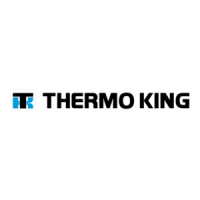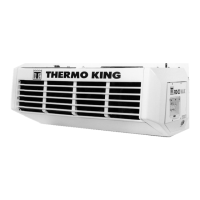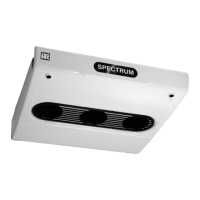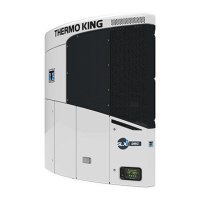
Do you have a question about the Thermo King RD-II SR 50 380-460/3/50-6 and is the answer not in the manual?
| Brand | Thermo King |
|---|---|
| Model | RD-II SR 50 380-460/3/50-6 |
| Category | Refrigerator |
| Language | English |
Essential safety rules for unit operation and maintenance.
Safety information regarding the unit's automatic start and stop functions.
Guidelines for safe handling of refrigerants and environmental protection.
Immediate medical assistance procedures for refrigerant-related injuries.
Safe practices for handling refrigeration oil and related first aid.
Precautions and first aid for high voltage electrical hazards.
Safety considerations for low voltage circuits and microprocessor handling.
Key engine data and procedures for setting belt tension.
Technical data for R-134a and R-404A refrigeration systems.
Details on the engine clutch and electrical control system components.
Details on electrical parts, standby operation, and power requirements.
Scheduled inspections and service for the engine system.
Scheduled inspections and service for the electrical system.
Scheduled inspections and service for the refrigeration system.
Scheduled inspections for structural integrity and parts.
General description of the RD-II SR unit and its capabilities.
Information about the X426 compressor used in the RD-II SR unit.
Explanation of the unit's instruments and optional remote indicator lights.
Details on system protection, operation, self-checks, and operating modes.
Steps for restarting, loading, and post-load checks.
Overview of the µP-T microprocessor control system.
Key components of the µP-T control system.
Function and location of the microprocessor power switch.
Details on the electric standby option for Model 50 units.
Features available on Model 50 units, standard and optional.
Description of the keypad, its keys, and their functions.
Explanation of the display layout, indicators, and status icons.
How to view the standard display and adjust the unit's setpoint.
Procedures for choosing between CYCLE-SENTRY and Continuous modes.
Starting the engine, manual defrost, and checking software version.
Navigating prompts, locking display, managing alarms, and performing unit self-checks.
General safety precautions for electrical maintenance tasks.
Details on alternators, voltage output, and charging system diagnostics.
Maintenance for battery, unit wiring, and electrical contacts.
Information on the 12 VDC charging system, preheat buzzer, and RPM sensor.
Testing RPM sensor, servicing glow plugs, and checking fan rotation.
Procedures for checking and adjusting the defrost air switch.
Maintenance for air switch and TherMax™ heating system operation.
Maintenance for oil systems, filters, breather, and air cleaner.
Details on the cooling system, antifreeze checks, and replacement procedures.
Details on the fuel system, filter replacement, and electric fuel pump.
Procedures for adjusting and timing the diesel engine's injection pump.
Procedures for adjusting valve clearance and information on the fuel limit screw.
Details on engine mounting system and idler assembly components.
Procedures for adjusting belt tensions and servicing the fuel solenoid.
Operation of the TK 3.95 engine and troubleshooting the fuel solenoid.
Introduction to evacuation, and procedures for setting up and testing equipment.
Procedures for evacuating the refrigeration system and charging it with refrigerant.
Procedures for removing hoses, leak detection, and testing refrigerant charge.
Procedures for checking compressor oil, testing high pressure cutout, and pump down.
Information on three-way valve operations and repair procedures.
Procedures for servicing coils, check valves, and dehydrators.
Procedures for removing and installing evaporator coils and expansion valve assemblies.
Procedures for removing the heat exchanger and cleaning the in-line screen.
Procedures for removing and installing pressure cutout switches, relief valves, and pilot solenoids.
Procedures for servicing pressure regulator valves, receiver tanks, and three-way valve bypass check valves.
Detailed procedures for repairing the three-way valve.
Procedures for checking and tightening unit and engine mounting bolts.
Guidelines for inspecting the unit for damage or loose components.
Methods for cleaning evaporator and condenser coils.
Proper positioning of the fan and hub assembly for optimal performance.
Procedures for checking and adjusting the defrost damper for proper operation.
Step-by-step instructions for disassembling and reassembling the jackshaft assembly.
Procedures for overhauling the fanshaft assembly, including disassembly and reassembly.
Method for checking and adjusting end play in assemblies.
Step-by-step procedure for installing the RD-II SR idler pulley seal.
Troubleshooting for when the unit switch is ON but no response.
Troubleshooting for when indicator lights are on but the engine does not crank.
Troubleshooting steps when the engine cranks but fails to start.
Troubleshooting for when the engine stops after initial starting.
Troubleshooting for when the engine lacks power or emits smoke.
Troubleshooting for engine knocking, overheating, low oil pressure, or high oil consumption.
Troubleshooting for smoke emissions and battery recharging issues.
Troubleshooting for no power or indicator lights on the electric standby system.
Troubleshooting for when the electric motor fails to run despite indicator lights.
Troubleshooting for electric motors that hum but do not operate.
Troubleshooting for contact issues, heater problems, and battery recharging in standby mode.
A diagnostic table linking symptoms to possible causes for refrigeration issues.
Further analysis of refrigeration symptoms and their potential causes.











